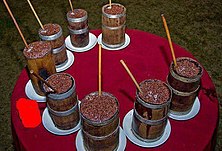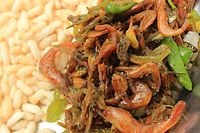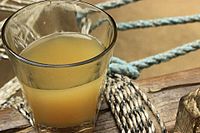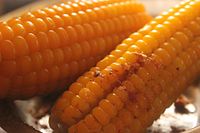Nepalese cuisine
This article needs additional citations for verification. (May 2015) |



Nepali/Nepalese cuisine comprises a variety of cuisines based upon ethnicity, soil and climate relating to Nepal's cultural diversity and geography. Dal-bhat-tarkari (Nepali: दाल भात तरकारी) is eaten throughout Nepal. Dal is a soup made of lentils and spices, served over boiled grain, bhat—usually rice but sometimes another grain - and a vegetable soup, tarkari. Condiments are usually small amounts of spicy pickle (achaar, अचार) which can be fresh or fermented, (mainly of dried mustard greens called as 'gundruk ko achar' and radish known as 'mula ko achar') and of which there are a considerable number of varieties.[1] Other accompaniments may be sliced lemon (nibuwa) or lime (kagati) with fresh green chilli (hariyo khursani) and a fried papad (thin, crisp disc-shaped food). Dhindo (ढिंडो) is a traditional food of Nepal.
Much of the cuisine is variations on Asian themes. Momo is a Nepalese style dumpling filled with minced meat in a flour dough, given different shapes and then cooked by steaming. It is one of the most popular foods in Nepal and the regions of Sikkim, Darjeeling and Kalimpong in India where ethnic Nepalese have a presence. Momo were originally filled with buffalo meat but are now commonly filled with goat or chicken, as well as vegetarian preparations. Special foods such as sel roti, finni roti and patre are eaten during festivals such as Tihar. Sel roti is a traditional Nepali homemade ring-shaped rice bread which is sweet to taste. Other foods have hybrid Tibetan and Indian influence.
Chow mein is a Nepali favorite in modern times based on Chinese-style stir fried noodles. It is one of the most beloved everyday staple lunches in Nepali/Nepalese households.
Types[]
Khas cuisine[]

Dal-bhat-tarkari is the standard meal eaten twice daily traditionally by the Khas people. However, with land suitable for irrigated rice paddies in short supply, other grains supplement or even dominate. Wheat becomes unleavened flat bread (roti or chapati). Maize (makai), buckwheat (fapar), barley (jau), or millet (kodo) become porridge-like (dhido or ato). Tarkari can be spinach and fresh greens (sag), fermented and dried greens (gundruk or sinki), white radish (mula), potatoes (alu), green beans (simi), tomatoes (golbeda), cauliflower (kauli), cabbage (bandakopi), pumpkin (farsi), etc. The climate of the hilly region remains moderate throughout the year. This kind of climate is perfect for horticulture.[2] Fruits traditionally grown in the hills include mandarin orange (suntala), kaffir lime (kagati), lemon (nibuwa), Asian pear (nashpati), and bayberry (kaphal). mangoes (aanp), apples (syauu), peach (aaru), plum (aalcha or aarubakhara), apricot (kurpani) .[3] In some seasons there is an excess amount of these fruits produced. These excess fruits are often preserved or otherwise made use of in the form of Alcohol, pickles, dried fruits and fruit juice.
Dahi (yogurt) and curried meat (masu) or fish (machha) are served as side dishes when available. Chicken (kukhura) and fish are usually acceptable to all including the Khas Brahmin (Bahun) caste. Observant Hindus never eat beef (gaiko masu). They also eschew buffalo and yak meat as being too cow-like. Domestic pork (sungurko masu) was traditionally only eaten by aadibasi, however wild boar (bangur ko masu) was traditionally hunted and eaten by magars. A strain derived from wild boar is now raised in captivity and used for meat that is increasingly popular with Pahari ethnicities and castes that did not traditionally eat pork. Khas Chhettris, however, eat Bandel (wild boar) as it is considered clean due to its forest habitat though they do not eat pork meat.
Himalayan cuisine[]
Tibetan-influenced cuisine[]

Himalayan cuisine is influenced culturally by Tibetan and closely related ethnic groups in the Himalaya and Trans-Himalaya. The Himalayan region is not fertile as compared to other regions. Moreover, the climate is cold throughout the year with heavy snowfalls.[4] The food crops grown in this region are buckwheat, millet, naked barley, common beans, and high-altitude rice.[5] Potatoes are another important staple crop and food. Substantial amounts of rice are imported from the lowlands.
Because of the cold temperature, people often prefer warm foods like soup, thukpa, tea and strong alcohols. Grains are made into alcoholic beverages (see below). Butter tea is made by mixing butter or ghyu (घ्यु)/ghee and salt into a strong brew of tea. This tea preparation is also commonly mixed with tsampa flour to make a kind of fast food, which is especially eaten while traveling.
The cattle raised in this region are yak, chauries (yak and cow crossed), Himalayan goats, and sheep.[6] People raise these animals for meat, milk, cheese, and dahi (yogurt).
Most of the Himalayan regions are hard to reach. There is no proper means of transportation because of higher altitudes and it is a considerable challenge to build good road transportation. Hence only rice and some spices like salt are imported from other regions by air transport or by using animals as their means of transportation.
People in this region eat dhido (millet or barley cooked dough), potato curry, momo (dumplings), yak or goat or sheep meat, milk, thukpa, laping or strong alcohol like tongba (millet juice) for their regular diet. This region also imports rice from other regions and consumes daal-bhat-tarkari from time to time.
Thakali cuisine[]
Thakali cuisine—transitional between Himalayan and lowland cuisines—is eaten by Thakali people living in Thak-Khola Valley, an ancient and relatively easy trade route through the high Himalaya. This cuisine is also served in inns (bhattis) run by Thakalis alongside other trade routes and in Pokhara and other towns in the hills of central Nepal, that were said to offer the best food and accommodations before the great proliferation of facilities catering to foreign trekkers.

Very few Thakali own their own yaks, so butter made from the yak milk is usually purchased at the market, along with other staples like rice, tea, lentils, sugar and spices. After butter is produced, a hard cheese called chhurpi is made with the buttermilk.[7]
Thakali cuisine is less vegetarian than Pahari cuisine. Yak and yak-cow hybrids locally known as Jhopa were consumed by the lower castes. All castes eat the meat of local sheep called Bheda and Chyangra or Chiru imported from Tibet. Meat is sliced into thin slices and dried on thin poles near the cooking fire. Blood sausage is also prepared and dried. Dried meat is added to vegetable curries or sauteed in ghee and dipped into timur-ko-choup which is a mixture of red chili powder, Sichuan pepper, salt and local herbs. This spice mixture also seasons new potatoes, or eggs which may be boiled, fried or made into omelets.
Thakali cuisine uses locally grown buckwheat, barley, millet and dal, as well as rice, maize and dal imported from lower regions to the south. Grain may be ground and boiled into a thick porridge that is eaten in place of rice with dal. A kind of dal is even made from dried, ground buckwheat leaves. Grain can be roasted or popped in hot sand (which is then sieved off) as a snack food. Thakalis also follow the Tibetan customs of preparing tsampa and tea with butter and salt. Ghee is used in this tea preparation and as a cooking oil otherwise.
Since most Thakali people were engaged in trade, they could import vegetables, fruits and eggs from lower regions. A large variety of vegetables were consumed daily, some—especially daikon radish and beetroot—dried and often prepared with mutton. Soup prepared from spinach known as gyang-to was served with a pinch of timur-ko-choup. Apples were introduced following the arrival of foreign horticulturists[8] and are now widely enjoyed.
Newars[]

Newars are an urbanized ethnic group originally living in the Kathmandu Valley, but now also in bazaar towns elsewhere in the world and Middle Hills. In the fertile Kathmandu and Pokhara valleys, local market farmers find growing produce more profitable than grain, especially now that cheap rice and other staples can be trucked in. Furthermore, Newar households have relatively high incomes and their culture emphasizes food and feasting.
Although daily Newar food practices consist mostly of components from the generic hill cuisine, during ritual, ceremonial and festive eating, Newar dishes can be much more varied than the generic Pahade/Pahari ones. Newari cuisine makes wide use of buffalo meat. For vegetarians, meat and dried fish can be replaced by fried tofu or cottage cheese. The cuisine has a wide range of fermented preparations, whereas Pahade/Pahari cuisine has beyond a few aachar condiments.
Kwāti (क्वाति soup of different beans), kachilā (कचिला spiced minced meat), chhoylā (छोयला water buffalo meat marinated in spices and grilled over the flames of dried wheat stalks), pukālā (पुकाला fried meat), wo (व: lentil cake), paun kwā (पाउँक्वा sour soup), swan pukā (स्वँपुका stuffed lungs), syen (स���येँ fried liver), mye (म्ये boiled and fried tongue), sapu mhichā (सःपू म्हिचा leaf tripe stuffed with bone marrow) and sanyā khunā (सन्या खुना jellied fish soup) are some of the popular festival foods.
Dessert consists of dhau (धौ yogurt), sisābusā (सिसाबुसा fruits) and mari (मरि sweets). There are achaars made with aamli fruit. Thwon (थ्वँ rice beer) and aylā (अयला local alcohol) are the common alcoholic liquors that Newars make at home.
There is great importance of food in Newari culture.[9] Newari cuisine is one of the most delicious food with intense flavorings.[10] There are dishes for every edible part of buffalo meat (cooked and uncooked) that includes intestine, stomach and brain.[11] That's another reason why they are famous.
Lohorung cuisine[]

Lohorung are indigenous to eastern Nepal. They have a variety of food in their cuisine made from local ingredients. Some of them are Wachipa, Wamik, Masikdaam, Sibring, Sel roti, Bawari, Dhule Achar, Saruwa, Chamre, Dibu, and so on.
Other ethnic variations in the Middle Hills[]
Buffalo meat and pork are eaten by many janajati (indigenous nationalities with customs departing from Hindu norms). More traditionally, Magars ate pork but not water buffalo while the superficially similar Gurung did the opposite. Further east, Tamang, Rai and Limbu have unique ethnic foods including kinema (fermented soybeans), yangben (Reindeer Moss), preparations of bamboo shoots, bread made from millet or buckwheat, and traditional Limbu drink tongba (millet beer).Beef is eaten in some Eastern regions like Dharan.[12][13]
Terai cuisine[]
Food in the Terai south of Sivalik Hills refers to mirror cuisines such as Maithili cuisine[14] in the east, Tharu cuisine in the west, and Bhojpuri cuisine in the center and near west of Madhesh region of Nepal. Further west, there is Mughlai-influenced Awadhi cuisine—particularly eaten by the substantial Muslim population around Nepalganj.
Terai diets can be more varied than in the Middle Hills because of greater variety of crops grown locally plus cash crops imported from cooler microclimates in nearby hill regions, as well as from other parts of Greater Nepal. Fruit commonly grown in the Terai include mango (aap), litchi, papaya (armewa/mewa), banana (kera/kela/kola) and jackfruit (katahar/katahal).
A typical terai set includes basmati rice with ghee, pigeon pea daal, tarkari (cooked variety of vegetable), tarua (battered raw vegetables known as taruwa/baruwa such as potato, brinjal/aubergine, chili, cauliflower etc. deep fried in the oil), papad/papadum, mango/lemon pickles and yogurt. For non-vegetable items, they consume mostly fish or goat curry. Traditionally there never used to be poultry items but nowadays, due to urbanization, poultry items are common, too.
Nepal has seven low elevation Inner Terai valleys enclosed by the Sivalik and Mahabharat ranges. Historically these valleys were extremely malarial and populated mainly by the Tharu and Maithil peoples who had genetic resistance. Since the valleys were isolated from one another, Tharu enclaves spoke different dialects and had different customs. They may have had different cuisines, although this has not been very well studied. Nevertheless, most Tharu historically obtained a varied diet through hunting and gathering as well as shifting agriculture and animal husbandry.
This contrasted with diets of Pahade/Pahari Hindus that were predominantly agricultural and used only a few sources of animal protein because of religious or caste prohibitions. In the 1950s, when Nepal opened its borders to foreigners and foreign aid missions, malaria suppression programs in the Inner Madhesh made it possible for people without genetic resistance to survive there. The Tharu and Maithil faced an influx of people fleeing land and food deficits in the hills. Conversion of forest and grassland to cropland and prohibitions on hunting shifted the Tharu and Maithil in the east and west away from land-based hunting and gathering, toward greater use of fish,[15] freshwater crab, prawns and snails from rivers and ponds.
Tharu raise chickens and are reported to employ dogs to hunt rats in rice paddies and then roast them whole on sticks. Mutton may be obtained from nomadic hill people such as Kham Magar who take herds of sheep and goats up to sub-alpine pastures bordering the high Himalaya in summer, and down to Inner Madhesh valleys in winter. Increasing competition for land forces the Tharu and Maithil people away from shifting cultivation toward sedentary agriculture, so the national custom of eating rice with lentils gains headway. The Tharu or Maithil have unique ways of preparing these staples, such as rice and lentil dumplings called bagiya or dhikri[16][17] and immature rice is used to make a kind of gruel, maar.
Taro root is an important crop in the region. The leaves and roots are eaten. Sidhara[18] is a mixture of taro root, dried fish and turmeric that is formed into cakes and dried for preservation. The cakes are broken up and cooked with radish, chili, garlic and other spices to accompany boiled rice. Snails are cleansed, boiled and spiced to make ghonghi.[19] Another short compendium of Tharu and Maithil recipes[20] includes roasted crab, wheat flatbread fried in mustard oil, and fried taro leaf cakes.
Sweets[]

Nepal produces a variety of fruits (persimmons, apples, mangoes, tangerines, kiwis) and nuts that are featured in locally prepared sweets. Dessert is not a well-established concept in the Nepali cuisine and sweets made with milk, yogurt and cheese are often eaten for breakfast as standalone meals. Sometimes grated carrots are used instead of flour, or semolina, rice, corn or puffed lotus seeds. Barfi is made with some combination of lentils, fruits, flour and thickened milk.[21]

Halwa is a sweetened semolina pudding with green cardamom, cashews, raisins and shredded coconut. Like other Nepalese sweets, Nepalese puddings are prepared using ghee. Dumplings called lal mohan are deep fried like fritters and soaked in cardamom-flavored sweet syrup.[21]
At the festival of Yomari Purnima celebrated in December, to thank the goddess of grains Annapurna after the harvest, the Newar make sweet dumplings (yomari) with rice flour filled with sesame seeds, and brown sugar or molasses. In the predominately Hindu country, sweet peda made with thickened milk (khuwaa) are offered to the Hindu gods.[21]
Snacks[]
Snacks include maize popped or parched called khaja (literally, "Eat and run."); beaten rice (baji or chiura), dry-roasted soybeans (bhatmas, Nepali: भटमास), dried fruit candy (lapsi), and South Asian foods like the samosa and South Asian sweets. International snacks like biscuits (packaged cookies), potato chips and wai wai (Nepali: वाइ वाइ, instant noodles) are all coming into widespread use. Whereas, some youths in Nepal prefer western snacks as they are easy to get and less time-consuming.
Drinks[]

Tea (chiya) usually taken with milk and sugar, juice of sugarcane (sarbat), and buttermilk (mahi) are common non-alcoholic drinks. Alcoholic drinks include raksi, spirits made in rustic distilleries, and jaand/jard, homemade beer made from rice. At higher elevations there is millet beer Tongba, nigaar and chhyaang.
Western influence[]
Western culture has influence in Nepali/Nepalese cuisine. Western food like bread, cereals, bagels, pizzas, sandwiches, burgers, and pastas, and drinks like Coke, Fanta, and Sprite are common in cities and places where there are a reasonable number of tourists. Middle-class families residing in cities consume these foods on a daily basis. One can find them in almost all the restaurants around cities.[22]
Etiquette[]
hideThis section has multiple issues. Please help or discuss these issues on the talk page. (Learn how and when to remove these template messages)
|
Although most homes and restaurants in cities have dining tables, meals in villages are often eaten seated on a tiny wooden seat (Pira) or on chairs or benches. A large mound of bhat, dhindo or a pile of rotis is served on a jharke thal (a large brass plate) or a khande thal (a compartment plate). On the jharke thal, the rice is surrounded by smaller mounds of prepared vegetables, fresh chutney or preserved pickles, and sometimes curd/yogurt, fish or meat. Separate glasses and bowls are instead used for different dishes, while serving on smaller plates or when serving to honoured guest or elders of the family. The most notable of this is the separate thals and bowls that are given to elders and honoured guests that are made of a separate metal alloy (jharke). Although it is vague on the specifics to what jharke can be quantified to be due to the change in the actual metallic composition of jharke for the past few generations and there being no one standard. Thus, jharke thals, bowls etc. can all vary in appearance from locality, era, craftsmanship, and more, however the sentiment still remains. On a khande thal, there are separate small compartments for chutney and tarkari and other dishes.
Food is traditionally eaten with the right hand. Touching or eating food with the left hand, which is traditionally used for washing off, after stool, is considered unhygienic, and taboo. The hands should be washed before eating, and the hand and mouth should be rinsed after. It is customary to wash your lips after eating. The use of spoons, and more recently forks, is also increasing, and inquiring if one is available is acceptable. The washing of hands and mouth is not necessary, before or after, when eating with a spoon.
In Nepal, especially among the Brahmin and chetry castes, the purity of food and drinks is taken very seriously. Contact with saliva is almost universally considered to make food impure, which is considered to be jutho and may be seen as a sign of insult or grave ignorance. Acceptability of jutho food follows the traditional hierarchy of respect, where parents' jutho is acceptable to children but not vice-versa and so on. People of equal standing, like friends and spouses may also share jutho, except among highly religious (where jutho is impure) or traditional people (where jutho is thought to transfer diseases, or husbands may be held superior to wives). In similar vein, food touched by pets and other animals ,or where an insect drops are discarded and the containers thoroughly washed. Some exceptions may be made for animals traditionally thought pure, such as cows and bees.
Although casteism has been officially outlawed,[23] it is not uncommon to encounter strong caste based discrimination from the Brahmin/chetry people of rural areas, as well as in highly religious families in the urban and affluent households. Religious elderly people may refuse eat meals cooked by people of lower castes, whereby, in a Brahmin family with a non-Brahmin daughter-in-law, where daughter-in-laws are in charge of the household chores and cooking, the elderly parents and grandparents may choose to cook their own food. The dalits may be highly discriminated in rural communities, where any water or food they touch, with the exception of fresh fruits and raw grains and beans, may be discarded. They may be made to sit separately from the rest during feasts, usually far from the kitchen. They may not be welcome inside the house and may be served their meals outside, on the porch or the lawn. The dalits may be made to collect water separately, when no one else is using the communal tap, spring or well. In case of stagnant water (like wells and ponds), the dalits may be barred altogether from using the communal sources. The foreigners may encounter racist interpretation of such rules of untouchability and purity, whereby white people may not face any discernible amount of discrimination, except while entering holy areas of the home; whereas Black and other dark-skinned people may be treated similar to dalits. Alcoholic beverages are seen as impure and drunk people may not be welcome to most Brahmin/chetry households, even in those that do not discriminate based on caste or race. Among the majority of Nepalese, including non-conservative Brahmin and Chetris, these traditional discriminatory practices are not encountered.
Gallery[]

Dried fish dish; Tharu Cuisine

Rice Wine; Tharu Cuisine

Dhikari; Tharu Cuisine

Chhwela; Newa Cuisine

Gwarcha; Newa Cuisine

Lapte Bhoye; Newa Cuisine

Boiled Corn with chilli pickle

Plateful of Momo in Nepal
See also[]
- Culture of Nepal
- Newari cuisine
- Chaat
- Sel roti
- Dal bhat
- List of Nepalese dishes
- Momo (dumpling)
- South Asian cuisine
- Jimbu
References[]
- ^ "Pickle - Achar - Chutney". Food-nepal.com. Retrieved 12 September 2010.
- ^ Hill Agriculture: Challenges and Opportunities
- ^ Deciduous Fruit Production in Nepal
- ^ Farming in Nepalese Mountains
- ^ Himalayan foods
- ^ Animal Life
- ^ Vinding, Michael. The Thakali: A Himalayan Ethnography. p. 102.
- ^ Lok Nath Devkota. "Deciduous Fruit in Nepal". FAO. Retrieved 14 October 2013.
- ^ "CHAPTER IV: CASTE AND FOOD". Archived from the original on 3 February 2019. Retrieved 13 December 2017.
- ^ Nepali Newari Food – Introduction to the Stimulating Flavors of Samay Baji
- ^ Kathmandu's hidden diners offer the real deal
- ^ "?About Historical and Contemporary Limbu Women of Nepal?". Forum.welovenepal.com. 24 June 2008. Archived from the original on 15 November 2016. Retrieved 12 September 2010.
- ^ "The Sikkim cuisines". Indiatraveltimes.com. Retrieved 12 September 2010.
- ^ "Nepali Mithila Cuisine". Mithilacuisine.blogspot.com. Retrieved 12 September 2010.
- ^ VOICE OF THARUS: Fishing and the Tharus including Maithil
- ^ Voice of Tharus: Bagiya – the rice flour dumplings made the Tharu way
- ^ "Tharu Cuisines and Delicacies (in Pictures) - The Nepali Food Blog | theGundruk.com". The Nepali Food Blog | theGundruk.com. 16 January 2016. Retrieved 15 September 2018.
- ^ VOICE OF THARUS: Sidhara – the colocasia concoction
- ^ VOICE OF THARUS: Excuse me, it’s escargot!
- ^ VOICE OF THARUS: Three mouth-watering Tharu dishes
- ^ Jump up to: a b c Roufs, Timothy G.; Roufs, Kathleen Smyth. Sweet Treats Around the World. pp. 179–183.
- ^ American Restaurants in Kathmandu
- ^ Nepal Prohibits Bias Against Untouchable Caste
Further reading[]
- Löwdin, Per (2002) [1986]. "Food, Ritual and Society: A Study of Social Structure and Food Symbolism among the Newars". Archived from the original on 30 June 2012. Retrieved 17 November 2013.CS1 maint: bot: original URL status unknown (link)
External links[]
- Nepalese Food
- Guide to Nepali food
- Saidi, Nicole. "In search of Nepal's culinary identity." CNN. 14 October 2011.
- Nepali food recipes Archived 5 May 2016 at the Wayback Machine
- Nepali food
- Authentic Nepali food
- Top 10 Nepali Foods Archived 19 December 2019 at the Wayback Machine
- Thakali food and it's recipe
- Nepalese cuisine







